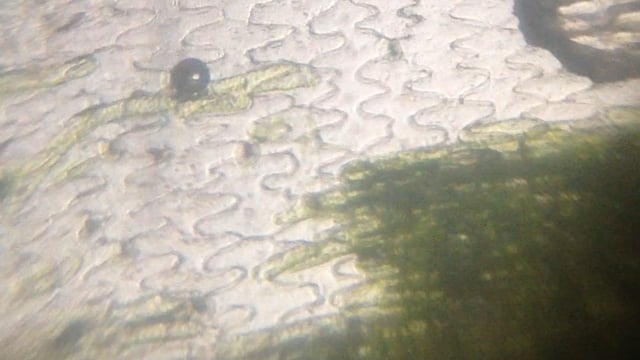Teaching histology (plant tissue) using foldscope.
 Feb 21, 2016 • 1:13 AM UTC
Feb 21, 2016 • 1:13 AM UTC Unknown Location
Unknown Location 140x Magnification
140x Magnification Microorganisms
Microorganisms
Cristina
Learn about the author...
19posts
52comments
1locations

As a Biology teacher, I do believe students do not only love but also need to learn by discovering Nature by themselves. Foldscope can make this goal realistic. This is an example of what they did a few days ago. Students (11 th grade) were learning about plant tissues, especifically about epidermal tissues. This array of examples made understanding pretty easy and encouraging. With the foldscope I have, we shot some images and videos and wanted to share them with you
We used flowers and leaves from a species of Freesia. Next images and video show epidermal cells and guard cells of the leaves. Contrary to what we expected, epidermal cells were multinuclear. They ressembled a jigsaw puzzle, all the pieces were different. From the video you can observe some exhibited two nuclei, others three ( which seemed so queer,…).
We used flowers and leaves from a species of Freesia. Next images and video show epidermal cells and guard cells of the leaves. Contrary to what we expected, epidermal cells were multinuclear. They ressembled a jigsaw puzzle, all the pieces were different. From the video you can observe some exhibited two nuclei, others three ( which seemed so queer,…).


In case there were thin cell walls we could not see, they stained some samples with methilene blue, and found nothing clearer.

They also saw the epidermis from the petals and proved it showed no stoma. Their shape had no relationship with the previous observed.

Later on, we observed hair- like extensions ( trichoma) beautifully arranged in the stigma and ready to capture pollen grains .

Al these types of cells were observed all together in an african violet leaf.

They stained it and enjoyed the beautiful architecture of cells.

Finally, they prepared a flower sample of a fountain grass plant and realised trichomes can harden their cell walls and act as microscopic thorns, an adaptation to increase dissemination efficiency.

Cristina Bosch
Sign in to commentNobody has commented yet... Share your thoughts with the author and start the discussion!

 0 Applause
0 Applause 0 Comments
0 Comments














